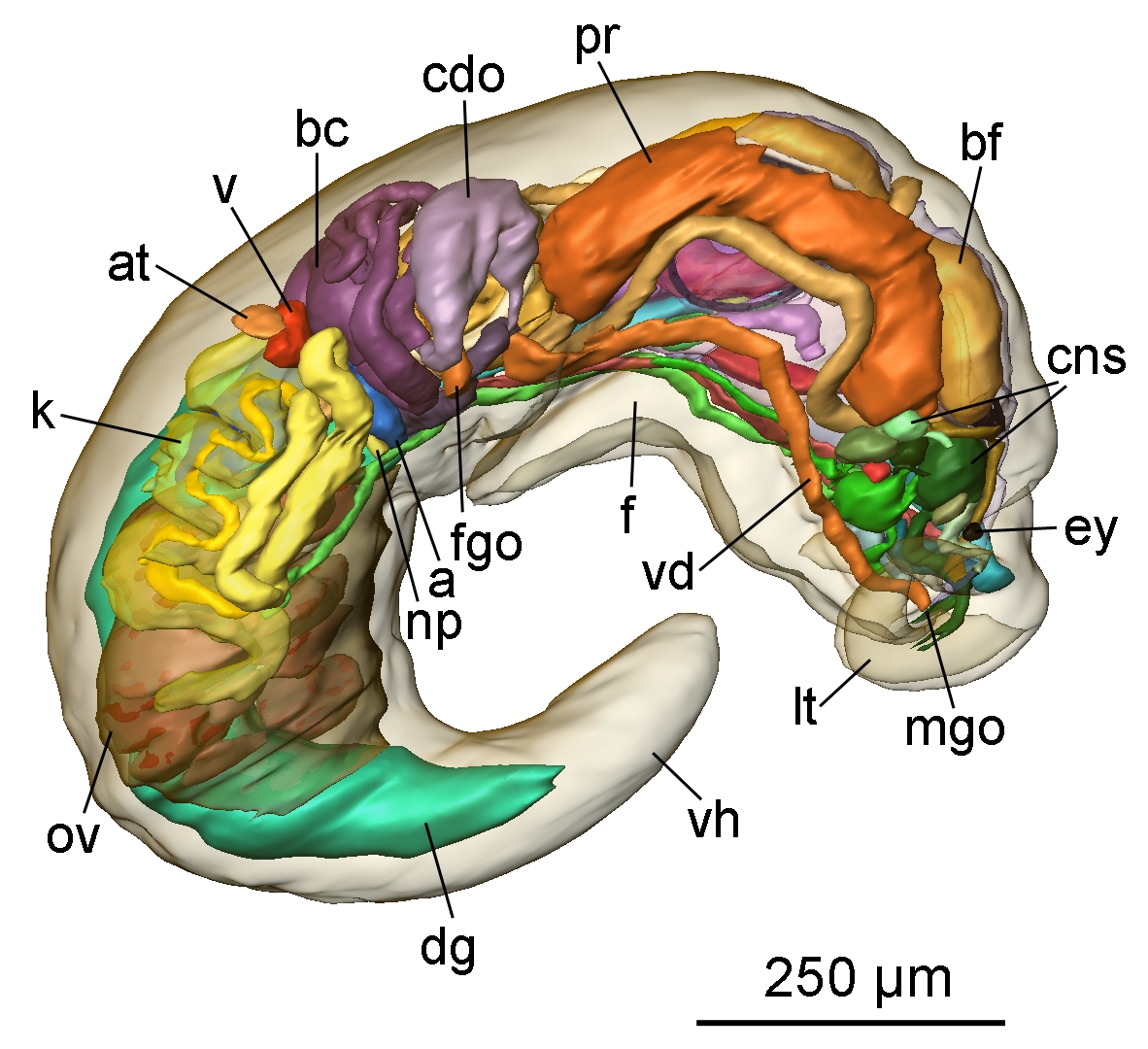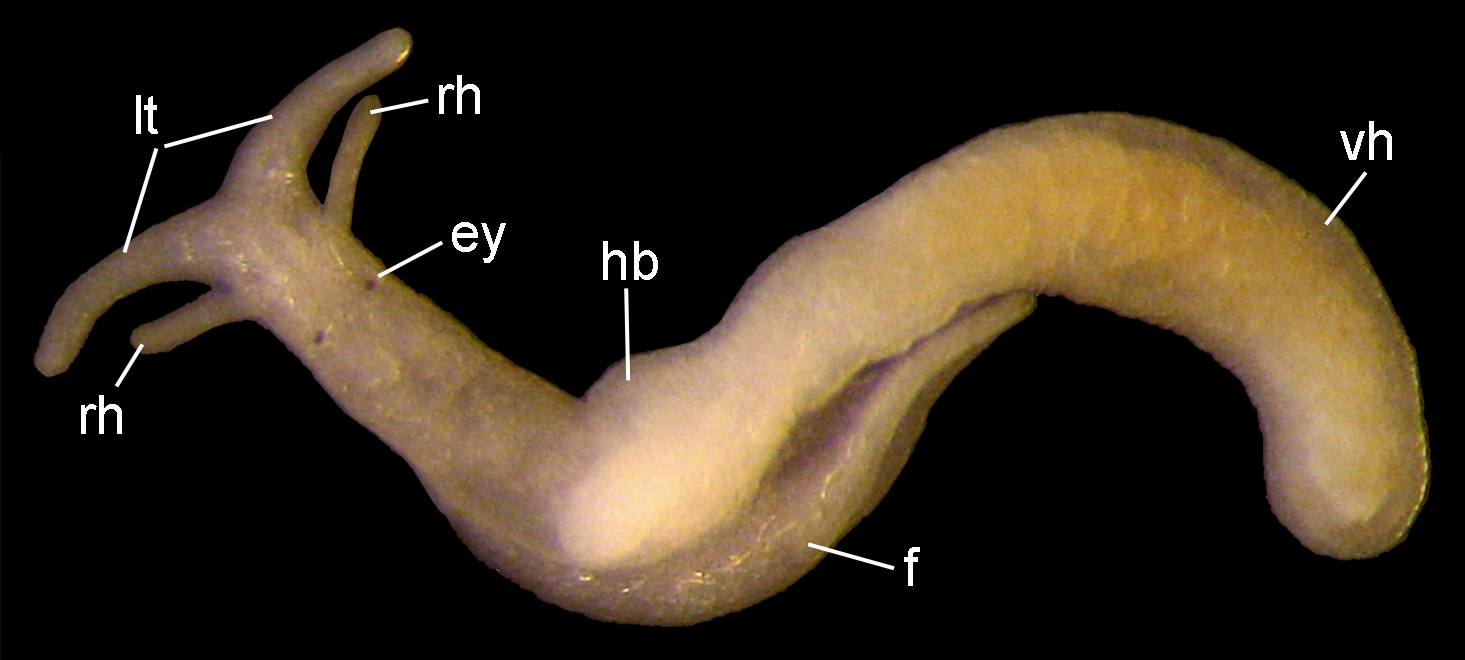|
Pseudunela
''Pseudunela'' is a genus of minute sea slugs, acochlidians, shell-less marine or temporary brackish or brackish gastropod mollusks in the clade Acochlidiacea. ''Pseudunela'' is the only genus in the family Pseudunelidae. ''Pseudunela'' is the type genus of the family Pseudunelidae. Taxonomy Pseudunelidae was placed within the superfamily Strubellioidea in the taxonomy of Bouchet & Rocroi (2005). Pseudunelidae was subsequently placed within the (unranked) Hedylopsacea by Schrödl & Neusser (2010).Schrödl M. & Neusser T. P. (2010). "Towards a phylogeny and evolution of Acochlidia (Mollusca: Gastropoda: Opisthobranchia)". ''Zoological Journal of the Linnean Society'' 158: 124-154. . Species These are the different species in the genus ''Pseudunela'': * ''Pseudunela cornuta'' (Challis, 1970) - type species of the genus ''Pseudunela'', marine and temporary brackish * ''Pseudunela eirene'' Wawra, 1988 - The description of ''Pseudunela eirene'' is brief and based on a single ... [...More Info...] [...Related Items...] OR: [Wikipedia] [Google] [Baidu] |
Pseudunela Cornuta
''Pseudunela cornuta'' is a species of minute sea slug, an acochlidian, a shell-less marine and temporarily brackishNeusser T. P., Jörger K. M. & Schrödl M. (2011). "Cryptic Species in Tropic Sands – Interactive 3D Anatomy, Molecular Phylogeny and Evolution of Meiofaunal Pseudunelidae (Gastropoda, Acochlidia)". '' PLoS ONE'' 6(8): e23313. figure 12. . gastropod mollusk in the family Pseudunelidae. Adults are about 3 mm long and live in the spaces between sand grains. A complex interactive 3D reconstruction (a 3D visualization based on 420 paraffin histological sections) of the body of an individual of this species has been available since 2009. Taxonomy ''Pseudunela cornuta'' is the type species of the genus '' Pseudunela''. Challis, who described the species in 1970, claimed to have deposited the holotype of ''Pseudunela cornuta'', 20 paratypes and a slide with the radula of a further paratype in the Natural History Museum, London; furthermore, he claimed t ... [...More Info...] [...Related Items...] OR: [Wikipedia] [Google] [Baidu] |
Pseudunela Eirene
''Pseudunela'' is a genus of minute sea slugs, acochlidians, shell-less marine or temporary brackish or brackish gastropod mollusks in the clade Acochlidiacea. ''Pseudunela'' is the only genus in the family Pseudunelidae. ''Pseudunela'' is the type genus of the family Pseudunelidae. Taxonomy Pseudunelidae was placed within the superfamily Strubellioidea in the taxonomy of Bouchet & Rocroi (2005). Pseudunelidae was subsequently placed within the (unranked) Hedylopsacea by Schrödl & Neusser (2010).Schrödl M. & Neusser T. P. (2010). "Towards a phylogeny and evolution of Acochlidia (Mollusca: Gastropoda: Opisthobranchia)". ''Zoological Journal of the Linnean Society'' 158: 124-154. . Species These are the different species in the genus ''Pseudunela'': * ''Pseudunela cornuta'' (Challis, 1970) - type species of the genus ''Pseudunela'', marine and temporary brackish * '' Pseudunela eirene'' Wawra, 1988 - The description of ''Pseudunela eirene'' is brief and based on a single s ... [...More Info...] [...Related Items...] OR: [Wikipedia] [Google] [Baidu] |
Pseudunela Viatoris
''Pseudunela viatoris'' is a species of sea slug, an acochlidian, a shell-less marine gastropod mollusk in the family Pseudunelidae. The specific name ''viatoris'' is after the Latin word “viator” (engl. pilgrim/voyager) according to its supposed ability to travel over long distances. Distribution ''Pseudunela viatoris'' is known from Viti Levu, Fiji and Gili Lawa Laut, Indonesia. The type locality is Fiji, Viti Levu, Laucala Bay, Nukumbutho Island, GPS: 18°10.47′S, 178°28.34′E. Description The body size of living specimens of ''Pseudunela viatoris'' is 3–4 mm. The body is divided into an anterior head-foot complex and a posterior elongated visceral hump. The paired labial tentacles are broad at the base and taper to the end. The rhinophores are tapered and shorter and thinner than the labial tentacles. The densely ciliated foot is as broad as the anterior head-foot complex and extends about one third of the elongated visceral hump. The heart bulb is v ... [...More Info...] [...Related Items...] OR: [Wikipedia] [Google] [Baidu] |
Acochlidian
Acochlidiacea, common name acochlidians, are a taxonomic clade of very unusual sea snails and sea and freshwater slugs, aquatic gastropod mollusks within the large clade Heterobranchia. Acochlidia is a variant spelling. Description These are mostly very small animals, without a shell or gills, distinguished by the visceral mass being sharply set off from the rest of the body. Being a small group with only 30 species worldwide known in 2010, and 32 species described in 2011, and 33 in 2012 (+9 undescribed ''Pontohedyle'' species), these slugs are morphologically and biologically highly aberrant and diverse, comprising a series of unusual characters (e.g. secondary gonochorism, lack of copulatory organs, asymmetric radulae). Most acochlidians live interstitially in marine sands, while some have conquered limnic systems (uniquely within opisthobranch gastropods). Taxonomy Nils Hjalmar Odhner established this taxon as a family in 1937, when he created the families Microhedylid ... [...More Info...] [...Related Items...] OR: [Wikipedia] [Google] [Baidu] |
Pseudunela Marteli
''Pseudunela marteli'' is a species of sea slug, an acochlidian, a shell-less marine gastropod mollusk in the family Pseudunelidae. The specific name ''marteli'' is in honour of author's "big-hearted friend and colleague" biologist Martin “Martl” Heß from Ludwig Maximilian University of Munich, because the species has a large heart-bulb. Distribution ''Pseudunela marteli'' is known from Guadalcanal, Solomon Islands and Oyster Island, Vanuatu. The type locality is beach of “Art Gallery”, Honiara, Guadalcanal, Solomon Islands. Description External morphology and anatomy of ''Pseudunela marteli'' is the same as in ''Pseudunela viatoris'' with the following exceptions: Colour of digestive gland is greenish or orange-brownish. Eyes (30–35 µm) are pigmented and well visible externally. Foot length is up to half of the visceral hump. Subepidermal spicules are more abundant in cephalic tentacles, foot and visceral hump. digestive system: the radula formula is 57� ... [...More Info...] [...Related Items...] OR: [Wikipedia] [Google] [Baidu] |
Acochlidiacea
Acochlidiacea, common name acochlidians, are a taxonomic clade of very unusual sea snails and sea and freshwater slugs, aquatic gastropod mollusks within the large clade Heterobranchia. Acochlidia is a variant spelling. Description These are mostly very small animals, without a shell or gills, distinguished by the visceral mass being sharply set off from the rest of the body. Being a small group with only 30 species worldwide known in 2010, and 32 species described in 2011, and 33 in 2012 (+9 undescribed ''Pontohedyle'' species), these slugs are morphologically and biologically highly aberrant and diverse, comprising a series of unusual characters (e.g. secondary gonochorism, lack of copulatory organs, asymmetric radulae). Most acochlidians live interstitially in marine sands, while some have conquered limnic systems (uniquely within opisthobranch gastropods). Taxonomy Nils Hjalmar Odhner established this taxon as a family in 1937, when he created the families Microhedylid ... [...More Info...] [...Related Items...] OR: [Wikipedia] [Google] [Baidu] |
Hedylopsacea
Acochlidiacea, common name acochlidians, are a taxonomic clade of very unusual sea snails and sea and freshwater slugs, aquatic gastropod mollusks within the large clade Heterobranchia. Acochlidia is a variant spelling. Description These are mostly very small animals, without a shell or gills, distinguished by the visceral mass being sharply set off from the rest of the body. Being a small group with only 30 species worldwide known in 2010, and 32 species described in 2011, and 33 in 2012 (+9 undescribed ''Pontohedyle'' species), these slugs are morphologically and biologically highly aberrant and diverse, comprising a series of unusual characters (e.g. secondary gonochorism, lack of copulatory organs, asymmetric radulae). Most acochlidians live interstitially in marine sands, while some have conquered limnic systems (uniquely within opisthobranch gastropods). Taxonomy Nils Hjalmar Odhner established this taxon as a family in 1937, when he created the families Microhedylid ... [...More Info...] [...Related Items...] OR: [Wikipedia] [Google] [Baidu] |
Pseudunela Espiritusanta
''Pseudunela espiritusanta'' is a species of sea slug, an acochlidian, a shell-less marine gastropod mollusk in the family Pseudunelidae. Its specific name is a reference to Espiritu Santo Island in Vanuatu, where it was found. This species, from Espiritu Santo Island in Vanuatu, lives in brackish water. The other two species in the genus '' Pseudunela'' are fully marine Marine is an adjective meaning of or pertaining to the sea or ocean. Marine or marines may refer to: Ocean * Maritime (other) * Marine art * Marine biology * Marine debris * Marine habitats * Marine life * Marine pollution Military * .... References Pseudunelidae Gastropods described in 2009 {{Heterobranchia-stub ... [...More Info...] [...Related Items...] OR: [Wikipedia] [Google] [Baidu] |
Taxonomy Of The Gastropoda (Bouchet & Rocroi, 2005)
The taxonomy of the Gastropoda as it was revised in 2005 by Philippe Bouchet and Jean-Pierre Rocroi is a system for the scientific classification of gastropod mollusks. (Gastropods are a taxonomic class of animals which consists of snails and slugs of every kind, from the land, from freshwater, and from saltwater.) The paper setting out this taxonomy was published in the journal ''Malacologia''. The system encompasses both living and extinct groups, as well as some fossils whose classification as gastropods is uncertain. The Bouchet & Rocroi system was the first complete gastropod taxonomy that primarily employed the concept of clades, and was derived from research on molecular phylogenetics; in this context a clade is a "natural grouping" of organisms based upon a statistical cluster analysis. In contrast, most of the previous overall taxonomic schemes for gastropods relied on morphological features to classify these animals, and used taxon ranks such as order, superorder ... [...More Info...] [...Related Items...] OR: [Wikipedia] [Google] [Baidu] |
Cladogram
A cladogram (from Greek ''clados'' "branch" and ''gramma'' "character") is a diagram used in cladistics to show relations among organisms. A cladogram is not, however, an evolutionary tree because it does not show how ancestors are related to descendants, nor does it show how much they have changed, so many differing evolutionary trees can be consistent with the same cladogram. A cladogram uses lines that branch off in different directions ending at a clade, a group of organisms with a last common ancestor. There are many shapes of cladograms but they all have lines that branch off from other lines. The lines can be traced back to where they branch off. These branching off points represent a hypothetical ancestor (not an actual entity) which can be inferred to exhibit the traits shared among the terminal taxa above it. This hypothetical ancestor might then provide clues about the order of evolution of various features, adaptation, and other evolutionary narratives about ance ... [...More Info...] [...Related Items...] OR: [Wikipedia] [Google] [Baidu] |
Zoosystema
''Zoosystema'' is a peer-reviewed scientific journal published by the National Museum of Natural History, France (''Muséum national d'histoire naturelle''), covering research in animal biodiversity. Specific subjects within the journal's scope include comparative, functional and evolutionary morphology, phylogeny, biogeography, taxonomy and nomenclature, among others. Zoosystema publishes articles in English and French. Indexing The journal is abstracted and indexed by Current Contents, Biological Abstracts, ASFA (Aquatic Sciences and Fisheries Abstracts), Pascal, Zoological Record, Journal Citation Index Expanded (SciSearch®) and Scopus Scopus is Elsevier's abstract and citation database launched in 2004. Scopus covers nearly 36,377 titles (22,794 active titles and 13,583 inactive titles) from approximately 11,678 publishers, of which 34,346 are peer-reviewed journals in top-l .... References {{reflist Zoology journals Animal science journals Open access journals Ac ... [...More Info...] [...Related Items...] OR: [Wikipedia] [Google] [Baidu] |




